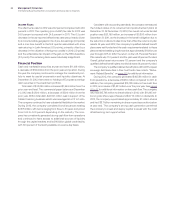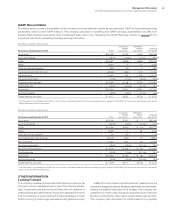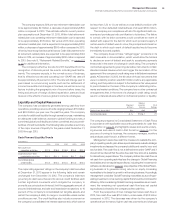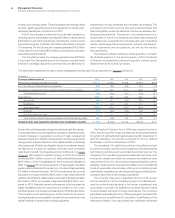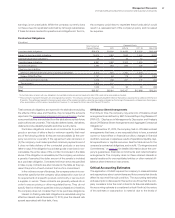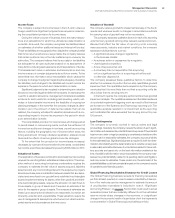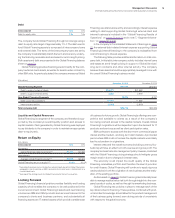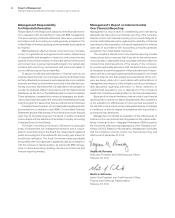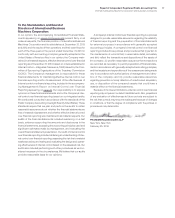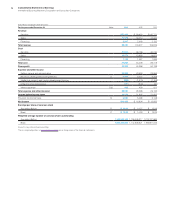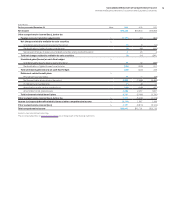IBM 2013 Annual Report Download - page 71
Download and view the complete annual report
Please find page 71 of the 2013 IBM annual report below. You can navigate through the pages in the report by either clicking on the pages listed below, or by using the keyword search tool below to find specific information within the annual report.
70 Management Discussion
International Business Machines Corporation and Subsidiary Companies
To the extent that actual collectibility differs from management’s
estimates currently provided for by 10 percent, Global Financing’s
segment pre-tax income and the company’s consolidated income
before income taxes would be higher or lower by an estimated $39
million (using 2013 data), depending upon whether the actual collect-
ibility was better or worse, respectively, than the estimates.
Residual Value
Residual value represents the estimated fair value of equipment
under lease as of the end of the lease. Residual value estimates
impact the determination of whether a lease is classified as operating
or capital. Global Financing estimates the future fair value of leased
equipment by using historical models, analyzing the current market
for new and used equipment, and obtaining forward-looking product
information such as marketing plans and technological innovations.
Residual value estimates are periodically reviewed and “other than
temporary” declines in estimated future residual values are recog-
nized upon identification. Anticipated increases in future residual
values are not recognized until the equipment is remarketed.
Factors that could cause actual results to materially differ from
the estimates include significant changes in the used-equipment
market brought on by unforeseen changes in technology innovations
and any resulting changes in the useful lives of used equipment.
To the extent that actual residual value recovery is lower than
management’s estimates by 10 percent, Global Financing’s segment
pre-tax income and the company’s consolidated income before
income taxes for 2013 would have been lower by an estimated
$94 million. If the actual residual value recovery is higher than man-
agement’s estimates, the increase in income will be realized at the
end of lease when the equipment is remarketed.
Currency Rate Fluctuations
Changes in the relative values of non-U.S. currencies to the U.S.
dollar affect the company’s financial results and financial position.
At December 31, 2013, currency changes resulted in assets and
liabilities denominated in local currencies being translated into fewer
dollars than at year-end 2012. The company uses financial hedging
instruments to limit specific currency risks related to financing trans-
actions and other foreign currency-based transactions. Further
discussion of currency and hedging appears in note D, “Financial
Instruments,” on pages 102 through 106.
Foreign currency fluctuations often drive operational responses
that mitigate the simple mechanical translation of earnings. During
periods of sustained movements in currency, the marketplace and
competition adjust to the changing rates. For example, when pricing
offerings in the marketplace, the company may use some of the
advantage from a weakening U.S. dollar to improve its position com-
petitively, and price more aggressively to win the business,
essentially passing on a portion of the currency advantage to
its customers. Competition will frequently take the same action.
Consequently, the company believes that some of the currency-
based changes in cost impact the prices charged to clients. The
company also maintains currency hedging programs for cash man-
agement purposes which mitigate, but do not eliminate, the volatility
of currency impacts on the company’s financial results.
The company translates revenue, cost and expense in its non-U.S.
operations at current exchange rates in the reported period.
References to “adjusted for currency” or “constant currency” reflect
adjustments based upon a simple constant currency mathematical
translation of local currency results using the comparable prior period’s
currency conversion rate. However, this constant currency method-
ology that the company utilizes to disclose this information does not
incorporate any operational actions that management may take in
reaction to fluctuating currency rates. Currency movements, particu-
larly the depreciation of the Yen, impacted the company’s year-to-year
revenue and earnings per share growth in 2013. Based on the currency
rate movements in 2013, total revenue decreased 4.6 percent as
reported and 2.5 at constant currency versus 2012. On a pre-tax
income basis, these translation impacts offset by the net impact of
hedging activities resulted in a theoretical maximum (assuming no
pricing or sourcing actions) decrease of approximately $400 million
in 2013. The same mathematical exercise resulted in a decrease of
approximately $100 million in 2012. The company views these amounts
as a theoretical maximum impact to its as-reported financial results.
Considering the operational responses mentioned above, movements
of exchange rates, and the nature and timing of hedging instruments,
it is difficult to predict future currency impacts on any particular period,
but the company believes it could be substantially less than the theo-
retical maximum given the competitive pressure in the marketplace.
For non-U.S. subsidiaries and branches that operate in U.S. dollars
or whose economic environment is highly inflationary, translation adjust-
ments are reflected in results of operations. Generally, the company
manages currency risk in these entities by linking prices and contracts
to U.S. dollars. The company continues to monitor the economic condi-
tions in Venezuela. On December 30, 2010, the official rate for essential
goods was eliminated, with no change to the SITME rate. The SITME
rate remained constant throughout 2012 and 2011. In February 2013, the
SITME rate was eliminated, and the official rate was set at 6.3 bolivares
fuerte (BsF) to the U.S. dollar. This devaluation did not have a material
impact given the size of the company’s operations in Venezuela (less
than 1 percent of total 2013 and 2012 revenue, respectively).
In addition, in March 2013, the Venezuelan government created
a new foreign exchange mechanism called the “Complimentary
System of Foreign Currency Aquirement.” This system operates
similar to an auction system and allows entities in specific sectors
to bid for U.S. dollars to be used for specific import transactions. In
December 2013, the Venezuelan regulation that created this mecha-
nism was amended to expand its use, and to require publication of
the average exchange rates implied by transactions settled in these
auctions. The company did not participate in this exchange mecha-
nism in 2013, and will consider its participation going forward.
In January 2014, the Argentinian government devalued its cur-
rency from 6 pesos to the U.S. dollar to 8 pesos to the U.S. dollar.
This devaluation will not have a material impact given the size of
the company’s operations in Argentina (less than 1 percent of total
2013 revenue).
Market Risk
In the normal course of business, the financial position of the
company is routinely subject to a variety of risks. In addition to the
market risk associated with interest rate and currency movements
on outstanding debt and non-U.S. dollar denominated assets and
liabilities, other examples of risk include collectibility of accounts
receivable and recoverability of residual values on leased assets.




